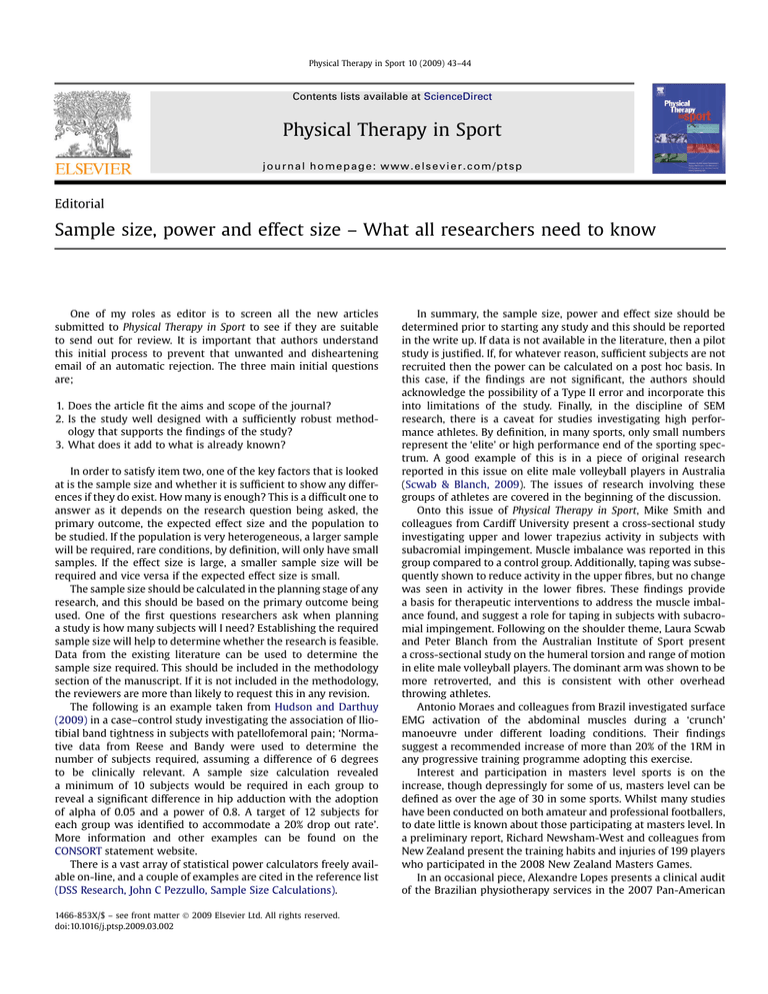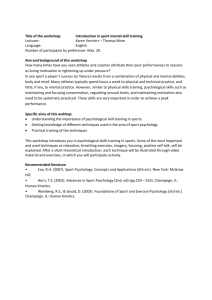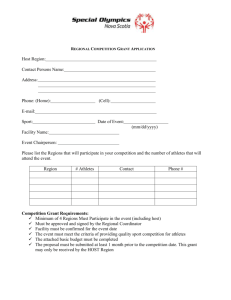
Physical Therapy in Sport 10 (2009) 43–44
Contents lists available at ScienceDirect
Physical Therapy in Sport
journal homepage: www.elsevier.com/ptsp
Editorial
Sample size, power and effect size – What all researchers need to know
One of my roles as editor is to screen all the new articles
submitted to Physical Therapy in Sport to see if they are suitable
to send out for review. It is important that authors understand
this initial process to prevent that unwanted and disheartening
email of an automatic rejection. The three main initial questions
are;
1. Does the article fit the aims and scope of the journal?
2. Is the study well designed with a sufficiently robust methodology that supports the findings of the study?
3. What does it add to what is already known?
In order to satisfy item two, one of the key factors that is looked
at is the sample size and whether it is sufficient to show any differences if they do exist. How many is enough? This is a difficult one to
answer as it depends on the research question being asked, the
primary outcome, the expected effect size and the population to
be studied. If the population is very heterogeneous, a larger sample
will be required, rare conditions, by definition, will only have small
samples. If the effect size is large, a smaller sample size will be
required and vice versa if the expected effect size is small.
The sample size should be calculated in the planning stage of any
research, and this should be based on the primary outcome being
used. One of the first questions researchers ask when planning
a study is how many subjects will I need? Establishing the required
sample size will help to determine whether the research is feasible.
Data from the existing literature can be used to determine the
sample size required. This should be included in the methodology
section of the manuscript. If it is not included in the methodology,
the reviewers are more than likely to request this in any revision.
The following is an example taken from Hudson and Darthuy
(2009) in a case–control study investigating the association of Iliotibial band tightness in subjects with patellofemoral pain; ‘Normative data from Reese and Bandy were used to determine the
number of subjects required, assuming a difference of 6 degrees
to be clinically relevant. A sample size calculation revealed
a minimum of 10 subjects would be required in each group to
reveal a significant difference in hip adduction with the adoption
of alpha of 0.05 and a power of 0.8. A target of 12 subjects for
each group was identified to accommodate a 20% drop out rate’.
More information and other examples can be found on the
CONSORT statement website.
There is a vast array of statistical power calculators freely available on-line, and a couple of examples are cited in the reference list
(DSS Research, John C Pezzullo, Sample Size Calculations).
1466-853X/$ – see front matter Ó 2009 Elsevier Ltd. All rights reserved.
doi:10.1016/j.ptsp.2009.03.002
In summary, the sample size, power and effect size should be
determined prior to starting any study and this should be reported
in the write up. If data is not available in the literature, then a pilot
study is justified. If, for whatever reason, sufficient subjects are not
recruited then the power can be calculated on a post hoc basis. In
this case, if the findings are not significant, the authors should
acknowledge the possibility of a Type II error and incorporate this
into limitations of the study. Finally, in the discipline of SEM
research, there is a caveat for studies investigating high performance athletes. By definition, in many sports, only small numbers
represent the ‘elite’ or high performance end of the sporting spectrum. A good example of this is in a piece of original research
reported in this issue on elite male volleyball players in Australia
(Scwab & Blanch, 2009). The issues of research involving these
groups of athletes are covered in the beginning of the discussion.
Onto this issue of Physical Therapy in Sport, Mike Smith and
colleagues from Cardiff University present a cross-sectional study
investigating upper and lower trapezius activity in subjects with
subacromial impingement. Muscle imbalance was reported in this
group compared to a control group. Additionally, taping was subsequently shown to reduce activity in the upper fibres, but no change
was seen in activity in the lower fibres. These findings provide
a basis for therapeutic interventions to address the muscle imbalance found, and suggest a role for taping in subjects with subacromial impingement. Following on the shoulder theme, Laura Scwab
and Peter Blanch from the Australian Institute of Sport present
a cross-sectional study on the humeral torsion and range of motion
in elite male volleyball players. The dominant arm was shown to be
more retroverted, and this is consistent with other overhead
throwing athletes.
Antonio Moraes and colleagues from Brazil investigated surface
EMG activation of the abdominal muscles during a ‘crunch’
manoeuvre under different loading conditions. Their findings
suggest a recommended increase of more than 20% of the 1RM in
any progressive training programme adopting this exercise.
Interest and participation in masters level sports is on the
increase, though depressingly for some of us, masters level can be
defined as over the age of 30 in some sports. Whilst many studies
have been conducted on both amateur and professional footballers,
to date little is known about those participating at masters level. In
a preliminary report, Richard Newsham-West and colleagues from
New Zealand present the training habits and injuries of 199 players
who participated in the 2008 New Zealand Masters Games.
In an occasional piece, Alexandre Lopes presents a clinical audit
of the Brazilian physiotherapy services in the 2007 Pan-American
44
Editorial / Physical Therapy in Sport 10 (2009) 43–44
Games. This will be of interest to any therapist providing services at
a multi-sport games with a squad large enough to warrant a central
HQ for assessment and treatment. Two thirds of the athletes
required some form of intervention during the games. However,
the data that continues to concern those involved with the care
of athletes is the recurrent theme in these audits of how many
athletes arrive at games carrying existing injuries. In this instance
22% of the athletes had existing injuries.
Onset timing of Vastus medialis and lateralis in subjects with
patellofemoral pain has dominated the literature in recent years.
Yiu-Ming Wong from Hong Kong presents a review of the literature
and highlights some of the issues of critiquing and comparing
studies utilising surface EMG.
Variations of eccentric training for hamstring injury are well recognised in the rehabilitation literature. In the last article of this issue,
Matt Brughelli and colleagues present a case study employing eccentric
training for an Australian football player with recurrent hamstring injury.
This is the second issue of the tenth volume and the ‘new look’
Physical Therapy in Sport. I am always more than happy to receive
any feedback you may have on the journal and I hope you enjoy
this issue.
References
CONSORT. Transparent reporting of trials. <http://www.consort-statement.org/
index.aspx?o¼1024>. Accessed 11.03.09.
DSS Research. Statistical power calculator. <http://www.dssresearch.com/toolkit/
spcalc/power.asp>. Accessed 04.03.09.
Hudson, Z., & Darthuy, E. (2009). Iliotibial band tightness and patellofemoral pain
syndrome: a case–control study. Manual Therapy, 14, 147–151.
John, C.. Pezzullo’s web pages that perform statistical calculations!. <http://
statpages.org/>. Accessed 04.03.09.
Sample size calculations. <http://www.sgul.ac.uk/index.cfm?DD25D103-C079-6609F78D-BC005970DCD9CAB35E63-88E4-4358-889C-043A012DF815>. Accessed
04.03.09.
Scwab, L. M., & Blanch, P. D. (2009). Humeral torsion and passive shoulder range in
elite volleyball players. Physical Therapy in Sport, 10, 51–56.
Zoe Hudson
by Editor






